Pulp magazines were inexpensive fiction magazines that were published from 1896 to the late 1950s. The term "pulp" derives from the cheap wood pulp paper on which the magazines were printed. In contrast, magazines printed on higher-quality paper were called "glossies" or "slicks". The typical pulp magazine had 128 pages; it was 7 inches (18 cm) wide by 10 inches (25 cm) high, and 0.5 inches (1.3 cm) thick, with ragged, untrimmed edges.

Oriental Stories, later retitled The Magic Carpet Magazine, was an American pulp magazine published by Popular Fiction Co., and edited by Farnsworth Wright. It was launched in 1930 under the title Oriental Stories as a companion to Popular Fiction's Weird Tales, and carried stories with far eastern settings, including some fantasy. Contributors included Robert E. Howard, Frank Owen, and E. Hoffman Price. The magazine was not successful, and in 1932 publication was paused after the Summer issue.
Henry Steeger III co-founded Popular Publications in 1930, one of the major publishers of pulp magazines, with former classmate Harold S. Goldsmith. Steeger handled editorial matters while Goldsmith took care of the business side. Both were veterans of the pulp magazine business. Steeger had edited war pulps at Dell Publishing while Goldsmith had served as an editor at A. A. Wyn's Magazine Publishers.
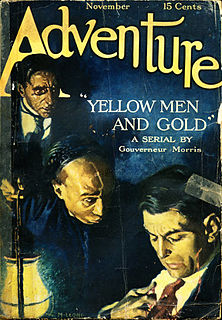
Adventure was an American pulp magazine that was first published in November 1910 by the Ridgway company, an subsidiary of the Butterick Publishing Company. Adventure went on to become one of the most profitable and critically acclaimed of all the American pulp magazines. The magazine had 881 issues. Its first editor was Trumbull White, he was succeeded in 1912 by Arthur Sullivant Hoffman (1876–1966), who would edit the magazine until 1927.
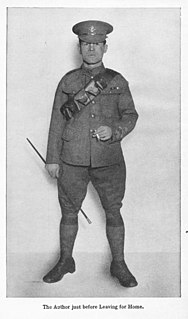
Arthur Guy Empey was an American soldier, author, actor and filmmaker. He served with the British Army during World War I, and upon his return wrote a popular autobiographical book, Over the Top, which sold over a quarter million copies. He penned lyrics to several patriotic songs, and wrote, produced or directed several silent films including The Undercurrent (1919) and Troopers Three (1930).

Amazing Stories Annual was a pulp magazine which published a single issue in July 1927. It was edited by Hugo Gernsback, and featured the first publication of The Master Mind of Mars, by Edgar Rice Burroughs, which had been rejected by several other magazines, perhaps because the plot included a satire on religious fundamentalism. The other stories in Amazing Stories Annual were reprints, including two stories by A. Merritt, and one by H.G. Wells. The magazine sold out, and its success led Gernsback to launch Amazing Stories Quarterly the following year.

The Shadow was an American pulp magazine that was published by Street & Smith from 1931 to 1949. Each issue contained a novel about the Shadow, a mysterious crime-fighting figure who had been invented to narrate the introductions to radio broadcasts of stories from Street & Smith's Detective Story Magazine. A line from the introduction, "Who knows what evil lurks in the hearts of men? The Shadow knows", prompted listeners to ask at newsstands for the "Shadow magazine", which convinced the publisher that a magazine based around a single character could be successful. Walter Gibson persuaded the magazine's editor, Frank Blackwell, to let him write the first novel, The Living Shadow, which appeared in the first issue, dated April 1931.
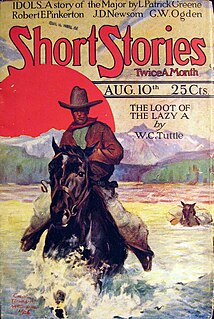
Short Stories was an American fiction magazine that existed between 1890 and 1959.

Doc Savage was an American pulp magazine that was published from 1933 to 1949. Street & Smith already had a successful hero pulp, The Shadow, and were interested in adding another. They planned to create one called The Phantom, but when Standard Publications launched The Phantom Detective in early 1933 the character of Doc Savage was created instead. Each issue ran a lead novel. Most were written by Lester Dent, but there were four ghost-writers—Harold A. Davis, Ryerson Johnson, Laurence Donovan, and Alan Hathway—until 1941, after which Dent wrote all the lead stories until 1946, when Bogard and Davis returned. The novels almost always featured science fiction elements, such as a metal-destroying ray, a teleportation mechanism, or the ability to revive a dead person from history. Despite this, Street & Smith considered Doc Savage to be an adventure magazine, not a science fiction magazine, so the short stories that accompanied the lead novel were straightforward adventure fiction. Writers who frequently contributed these stories included Steve Fisher, Laurence Donovan, and William Bogart.
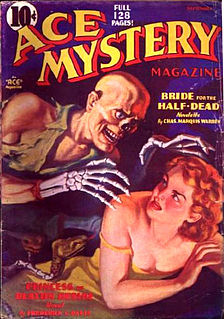
Ace Mystery was a weird menace pulp magazine which published three issues starting 1936, followed by two more under the title Detective Romances. It was published by Periodical House and edited by Harry Widmer. Writers who appeared in the magazine included Frederick C. Davis, who wrote all three lead novels, Hugh B. Cave, and Robert C. Blackmon; magazine historian Michael Cook comments that these were capable writers, but the rest of the magazine was too low-quality to succeed. Some of the stories were fantasy rather than weird menace -- for example, one story was about a sculptor who could shrink dead bodies. Science fiction historian Mike Ashley is more positive than Cook, describing the magazine as "of reasonably good quality", and singling out Charles Marquis Warren's "Coyote Woman" for praise; Ashley quotes pulp historian Robert K. Jones, who considered the "Coyote Woman" "...among the most effective vampire stories to appear in the pulps".
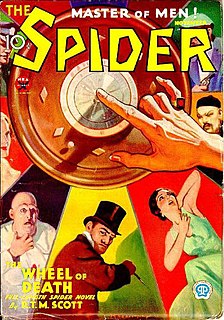
The Spider was an American pulp magazine that was published from 1933 to 1943. It included a lead novel in every issue that featured The Spider, a heroic crimefighter. It was published by Popular Publications, as a rival to Street & Smith's The Shadow and Standard Magazine's The Phantom Detective. Many of the stories involved science fiction plot devices, such as a metal-eating virus, or giant robots.
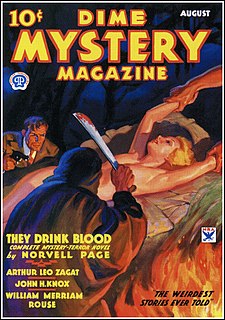
Dime Mystery Magazine was an American pulp magazine that was published from 1932 to 1950. It was the first terror fiction pulp magazine, and was the instigator of a trend in pulp fiction that came to be called weird menace fiction, in which the protagonist struggles against something that appears to be supernatural, but ultimately can be explained in everyday terms. Initially Dime Mystery contained ordinary mystery stories, but with the October 1933 issue it began publishing terror fiction. The publisher, Harry Steeger, later said he was inspired to create the new genre by the Grand Guignol theater in Paris. In 1938 it returned to detective stories once again. The stories occasionally included science fiction elements, such as robots, and drugs that can alter the flow of time. In 1950 it briefly changed its title to 15 Mystery, but ceased publication at the end of that year.

Jungle Stories was an American pulp magazine published from 1938 to 1954. The lead stories featured the adventures of Ki-Gor, the son of a Scottish missionary raised in the jungle like Tarzan. For the first two years, the novels formed a continuous narrative, including Ki-Gor meeting Helene Vaughan, a pilot who crashes in the jungle and is saved by Ki-Gor; they later marry. After 1940, the novels were unconnected episodes featuring both of them fighting perils that included some science fictional tropes such as talking gorillas and dinosaurs. The first novel was written by John M. Reynolds; all the later novels were listed under the house name "John Peter Drummond". Some of these were written by Stanley Mullen, but the authors of the others are unknown. Short stories appeared alongside the lead novel in each issue, from authors including Wilbur S. Peacock, Duane Rimel, Dan Cushman, Bryce Walton, and E. Hoffman Price.
The Western Raider was an American pulp magazine. The first issue was dated August/September 1938; it was followed by two more issues under that title, publishing Western fiction, and then was changed to a crime fiction pulp for two issues, titled The Octopus and The Scorpion. Both these two issues were named after a supervillain, rather than after a hero who fights crime, as was the case with most such magazines. Norvell Page wrote the lead novels for both the crime fiction issues; the second was rewritten by Ejler Jakobsson, one of the editors, to change the character from The Octopus to The Scorpion.

The Mysterious Wu Fang was a pulp magazine which published seven issues in 1935 and 1936. Sax Rohmer's Fu Manchu, an oriental villain, was a "yellow peril" stereotype, and Popular Publications wanted to take advantage of the public's interest. The author of all seven lead novels was Robert J. Hogan, who was simultaneously writing the novels for G-8 and His Battle Aces, producing 130,000 to 150,000 words per month; Hogan was told to not to rewrite, but to deliver his first drafts. The hero of the novels was a man named Val Kildare; other characters included a young assistant to Kildare, who was probably added to attract younger readers. The artist John Richard Flanagan, who had experience illustrating Fu Manchu, was hired, but in the opinion of pulp historian Robert Weinberg, "an imitation was an imitation, and the magazine did not sell well". There were short stories along with the lead novel in each issue, also with a "yellow peril" theme; the authors included Steve Fisher, Frank Gruber, O.B. Meyers, and Frank Beaston. The magazine was cancelled after seven issues in favor of a similar magazine with a different villain: Dr. Yen Sin. According to pulp historian Joseph Lewandowski, the decision to switch titles may have been because Wu Fang was too juvenile, and Dr. Yen Sin was supposed to be more mature.

Operator #5 was a pulp magazine published between 1934 and 1939. The lead novels featured Operator #5, whose real name was Jimmy Christopher of the Secret Service. The novels were written by Frederick C. Davis until November 1935, then by Emile C. Tepperman until March 1938, and then Wayne Rogers for the remainder of the run; all three used the house name "Curtis Steele" on all their work for Operator #5. The plots always involved science fictional ideas such as revival of the dead, sonic rays that could cause panic, rays that damaged the ionosphere, and future war scenarios. Both Tepperman and Rogers embedded their novels in longer story arcs that went on for many issues, involving the invasion of America. In Tepperman's case the invading force was the Purple Empire; in Rogers' case it was the Japanese, and the sequence was unresolved when the magazine was cancelled in 1939, with the Japanese dropping atom bombs on American cities. The short stories that accompanied the lead novel were often spy stories, and included series with repeating characters such as Red Finger and John Vedders, Secret Service Agents whose adventures were chronicled by Arthur Leo Zagat and Frank Gruber, respectively.
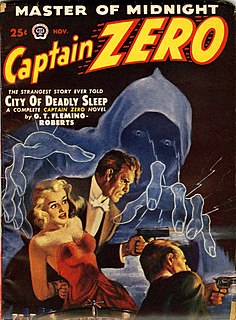
Captain Zero was an American pulp magazine that published three issues in 1949 and 1950. The lead novels, written by G.T. Fleming-Roberts, featured Lee Allyn, who had been the subject of an experiment with radiation, and as a result was invisible between midnight and dawn. Under the name Captain Zero, Allyn became a vigilante, fighting crime at night. Allyn had no other superpowers, and the novels were straightforward mysteries in Weinberg's opinion, though pulp historian Robert Sampson considers them to be "complex...[they] pound along with hair-raising incidents..full of twists and high suspense". Captain Zero was the last crime-fighter hero magazine to be launched in the pulp era, ending an era that had begun with The Shadow in 1931. There was room in the magazine for only one or two short stories along with the lead novel; these were all straight mystery stories, without the veneer of science fiction of the Captain Zero novels.

G-8 and His Battle Aces was an American air-war pulp magazine published from 1930 to 1944. It was one of the first four magazines launched by Popular Publications when it began operations in 1930, and first appeared for just over two years under the title Battle Aces. The success of Street & Smith's The Shadow, a hero pulp, led Popular to follow suit in 1933 by relaunching Battle Aces as a hero pulp: the new title was G-8 and His Battle Aces, and the hero, G-8, was a top pilot and a spy. Robert J. Hogan wrote the lead novels for all the G-8 stories, which were set in World War I. Hogan's plots featured the Germans threatening the Allied forces with extraordinary or fantastic schemes, such as giant bats, zombies, and Martians. He often contributed stories to the magazines as well as the lead novel, though not all the short stories were by him. The cover illustrations, by Frederick Blakeslee, were noted for their fidelity to actual planes flown in World War I.
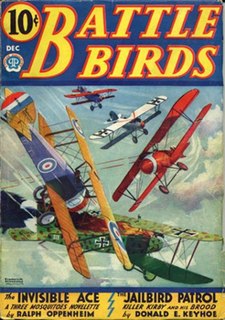
Battle Birds was an American air-war pulp magazine, published by Popular Publications. It was launched at the end of 1932, but did not sell well, and in 1934 the publisher turned it into an air-war hero pulp titled Dusty Ayres and His Battle Birds, with Robert Sidney Bowen, an established pulp writer, providing a lead novel each month, and also writing the short stories that filled out the issue. Bowen's stories were set in the future, with the United States menaced by an Asian empire called the Black Invaders. The change was not a success, and after a year Bowen wrote a novel in which, unusually for pulp fiction, Dusty Ayres finally defeated the invaders, and the magazine ceased publication. It restarted in 1940, again under the original title, Battle Birds, and lasted for another four years.
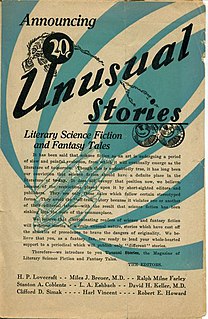
Marvel Tales and Unusual Stories were two related American semi-professional science fiction magazines published in 1934 and 1935 by William L. Crawford. Crawford was a science fiction fan who believed that the pulp magazines of the time were too limited in what they would publish. In 1933, he distributed a flyer announcing Unusual Stories, and declaring that no taboos would prevent him from publishing worthwhile fiction. The flyer included a page from P. Schuyler Miller's "The Titan", which Miller had been unable to sell to the professional magazines because of its sexual content. A partial issue of Unusual Stories was distributed in early 1934, but Crawford then launched a new title, Marvel Tales, in May 1934. A total of five issues of Marvel Tales and three of Unusual Stories appeared over the next two years.

















